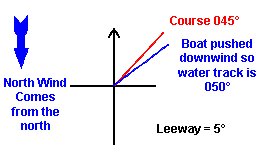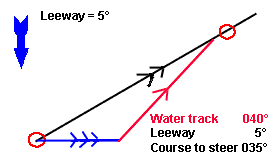Navigation and Chart work - Leeway
When we navigate there is another factor we have to allow for, and that is the effect of the wind blowing on the side of the boat. The force of the wind drives the boat slightly sideways; this sideways motion is called leeway.
It is essential to understand two phrases commonly used:
Course Steered
This is the direction the vessel is pointing.
Water Track
This is the direction the vessel travels through the water, and is the result of the course steered and any leeway.
Leeway is at the maximum when a sailing boat is beating or sailing against the wind, but it will also occur when motoring if the wind is strong enough. Factors, which increase leeway are:
-
Wind angle
A wind blowing on to the boat at an angle of 45° to the bow will cause more leeway than one on the beam. There will be none with the wind astern.
-
Boat design
Bilge keel yachts (twin keels) make more leeway than fin keeled ones in the same conditions. Yachts that are relatively beamy will slip sideways more when they heel than a yacht with a deeper draught. Most modern cruising yachts should be reefed down early to enable them to sail more upright to reduce the leeway, whereas older designs tend to have a deeper keeled narrow hull form that is more tolerant of heeling.
-
Wind force
The stronger the wind, the more leeway.
-
Sea state
Rough weather will increase leeway, because the boat will be carried sideways by breaking waves. In rough seas the boat can be felt to be swept a metre or two down wind when a wave breaks on the windward side of the vessel, this is especially the case if the boat is stopped by the force of a wave.
-
Boat speed
Leeway increases as boat speed decreases. On a vessel that can make 30 knots, leeway will be minimal and for practical purposes can normally be ignored. However, if the sea state is such that the same vessel can only make 5 knots, the leeway may be considerable, especially on a high sided modern motor vessel.
-
Helming ability
Novice helmsmen often increase leeway because they do not drive the boat efficiently, frequently slowing down by sailing too close to the wind, then too far off and making the boat heel excessively. A good helm will keep the boat moving along at a good speed with relatively little alteration of course when sailing upwind.
When planning the time for a passage upwind with beginners, I normally allow twice the straight line distance to allow for the slow upwind speed.
How many degrees to allow for?
It is very difficult to decide how much leeway there is, but if you assume you are being pushed about 5° downwind when you are beating you will not be far out in normal conditions. In heavy weather I have occasionally allowed for 20° of leeway.
In practice most navigators guess at a figure, and then adjust it depending on how accurate the resulting navigation is. Over time, you will build up an idea of how the leeway of your boat varies with the conditions.
When I am sailing on a Sigma 38 (Fairly high performance cruiser/racer) I would normally allow 3° for leeway when beating. If I am sailing a Westerly Fulmar (an average cruising yacht) I would allow 7° in the same conditions.
How to apply leeway with an EP
Leeway is always downwind. When we are plotting an EP. It has already happened to the boat, so the water track we draw on the chart is a combination of the course steered and leeway.
happened to the boat, so the water track we draw on the chart is a combination of the course steered and leeway.
At first it is a good idea to draw something like this diagram on a piece of paper. It often helps to have a visual representation of how the leeway will affect the vessel.
In this case the water track to plot on the chart is 050°T. This is the only line you plot. You never try to plot a separate line for leeway on the chart, it is dealt with before you draw anything on the chart!
How to apply leeway when working out the course to steer
When you plot a course to steer there is no difference in the diagram if  there is leeway or not. The leeway is applied after the water track has been found from the course to steer plot.
there is leeway or not. The leeway is applied after the water track has been found from the course to steer plot.
In this example the required water track is 040° but as the wind will push the boat down wind we need to steer 5° up into the wind, giving a course to steer of 035°.
Leeway, Variation and Deviation
Because allowances for leeway will alter the vessel's heading we need to be careful about the order that leeway, variation and deviation are applied, or we may end up with the wrong figure for deviation.
When plotting a course to steer, the course is found from the plot, the corrections should be applied in the following order:
Water Track ± Leeway ± Variation ± Deviation = Course to Steer (C)
If the Water Track needs to be 040°T and there is 20° of leeway from a southerly wind the boat needs to steer 060°T.
If the Variation is 7°W the Magnetic course is 067°M (See CADET Rule)
Using the deviation table, the deviation for this course is 2°E giving a Compass course of 065°C.
If the leeway was applied last, the figure for deviation indicated by the table would be 0° (040°T+7°W = 047°M).
When plotting an EP, the sequence is:
Course Steered ± Deviation ± Variation ± Leeway = Water Track (T)
In practice the order of application only makes a small difference and then only if the leeway is considerable.
In Summary
Leeway is something that you should always consider when navigating, you may choose to ignore it and in practice many people do but if you do, it should be a measured judgment, rather than something you forgot.
For most of the sailing you do in coastal waters allowing for leeway will not matter much, but when in extremes of weather (strong winds or fog) or when near to hazards it would be foolhardy not to take leeway in to account, so it is good practice to consider it on every leg of a passage.
Additional Resources:

